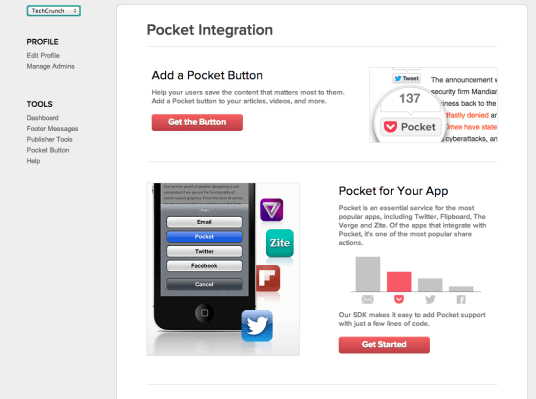Pocket, the save-for-later service that evolved from ReadItLater, is introducing new publisher tools today, including a way to see how content saved to the platform is performing, a button that publishers can add to their site to let visitors instantly save content, mobile app tools and custom footer messages for readers checking out your content in Pocket itself.
The new tools for publishers are designed to help Pocket continue to capitalize on its ability to extend the life of content – something that content producers, especially on the web, are very interested in doing. When Twitter and Facebook are among your highest referrers, the lifespan of any specific article tends to be very brief: it’s published, it flickers briefly and then it’s crushed by a wave of “new,” which is the number one currency on social networks.
Pocket has recently shown that its platform can give articles from major pubs a big boost when other channels have run out of steam. It showed that a Verge article on the Surface Pro managed to spread out 80 percent of its readership over the course of six days, versus just two for the same on Twitter. For publishers, that looks mighty attractive, since it’s readership through a new channel that they likely wouldn’t have had elsewhere. The new publisher tools are designed to add even more value on the publisher side, with free tools that anyone can use via Pocket’s new web and mobile software developer tools.
“We’ve always talked quite a bit about publishers and their needs,” Pocket Editorial Director Mark Armstrong explained in an interview. “We’ve been trying to understand how we could be helpful, frankly. There were a lot of things that we were learning about this as well, and one is that publishers have a lot of very diverse interest and needs. Some are focused on social, some on growing readerships, some on paywalls. We wanted to formalize the relationship with publishers, and it boiled down to that the very first step was that they wanted clarity.”
[gallery columns="4" ids="785472,785473,785474,785475"]
Pocket says they know their service is changing the way readers consume content, but it was imperative to lay that out in a straightforward manner for publishers, so they could easily grasp the effect Pocket and save-for-later has on their audience and how their content is consumed. That led to the creation of the Publisher Tools, which include analytics that show how content is performing in Pocket, which articles are getting the most traction from a pure popularity perspective, which are better in terms of quality and attracting loyal readers, and which authors are among your top saved.
Pocket also now has a “Save to Pocket” button for websites to build into their page, much like the social share buttons that exist for Twitter and Facebook, and the option to add Pocket integration to mobile apps, too. Plus, it also offers site subscription for those publishers who have introduced a paywall, and a new custom footer option that allows publishers to specify what should appear at the bottom of any article or video saved from their site.
The footer in particular is an interesting new addition. Pocket says that publishers can do whatever they want with it: direct users back to related content from their site; use it to promote their social media accounts; even direct people to newsletters or other forms of content digests that are potentially even competitive with Pocket itself. I asked if you could even theoretically display a banner ad, and Pocket said that it was completely up to publishers to determine what appears there, but it’s text-only for now. It’s a good faith gesture, with Pocket acknowledging that the content is most definitely the publisher’s, and giving them more influence over how it appears in Pocket’s service.
Pocket says its monetization plans are distinct from these publisher efforts, so the free tools it’s providing will remain so. Publishers are already seeing the value proposition, too; launch partners including GigaOM, WordPress, The Verge, Wired, Buzzfeed, Bloomberg Businessweek, USA Today and more. The ultimate aim for Pocket is to become as important a publication and sharing channel as Twitter and Facebook, but with a value proposition and role among readers that is complementary to, not competitive with, those media giants. The publisher program is a way to deal directly with publishers to help make that happen, and a very promising one, based on this inaugural version.
